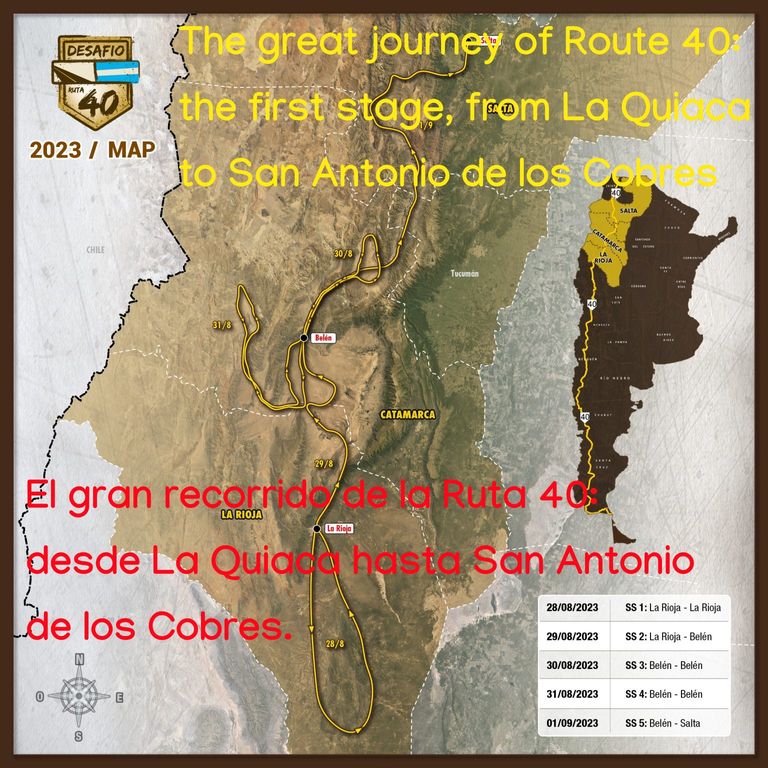
The most famous route in Argentina is Route 40. Five years ago I made this journey. And today I will tell you. With a previous introduction in this same Community.
In La Quiaca there is a continuous exchange of merchandise in general in the large open-air market. From groceries to toys.
It is a continuous flow of people who give from one side to another. From one country to another.
In the center of the city, trying to give an image of peace and tranquility, the imposing figure of the church predominates.
People are simple and friendly. Time runs slowly. No one rushes. No one constantly watches the clock like we do in big cities.
Time seems to have stopped.
The people of La Quiaca have indigenous blood.
The hustle and bustle in the courtyard of the Villazó La Quica border is hellish.
Each passenger's baggage is thoroughly checked. And the time to pass is getting longer.
After completing all the bureaucracy of the immigration office, we can finally leave. Free way!
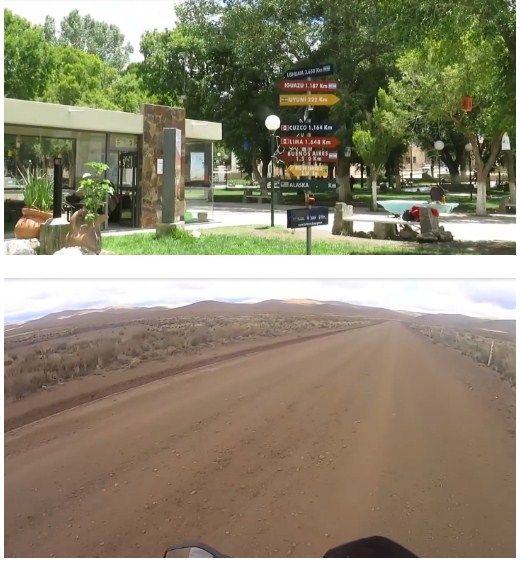
We crossed (me and my motorcycle) the bridge over the dry river of La Quiaca that separates or divides both countries.
The dispute of this font led in the past to many rivalries and fights between the two South American countries.
Until not long ago a train arrived.
This part of Route 40 starting from the north is one of the parts not yet paved. The gravel and the uncompacted soil put my bike to the test.
and it has that copper color that characterizes The Puna.
Continuous descents and ascents that, despite appearing bleak, have their charm.
Despite the fact that the climate is arid and semi-desert, traveling in summer we come across some lagoons and puddles that are the result of recent rains.
The time when it rains the most is from October to March.
The wind is cold and strong. For this reason almost all the doors and windows of the houses are always closed. It is not out of fear but to prevent the entry of dirt and dust into the houses. And it contrasts with the hospitality of the people.
Warnings intended to travel with caution along the dirt roads are quite common.
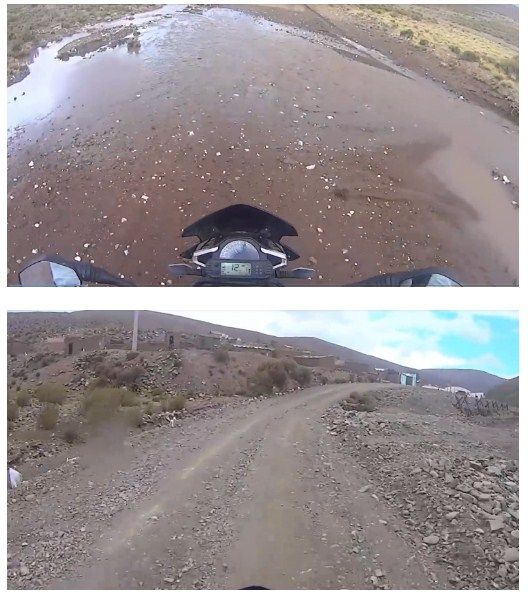
And finally I see the first signs of animal life: the typical animal flames and symbol of the Puna jujeña.
People don't know you but greet you as you pass.
People who appreciate the spirit of the traveler and his desire to know.
Here we are 11 kms above the bed of the Paicone gorge
These lands seem out of the palette of a painter. And in fact that is the name of one of these multi-colored hills. Here, evergreen flowers are cultivated and there are some works of rock art.
Sometimes the colors of La Puna seem to merge into the very color of the territory, with its muddy towns and its people without haste.
People have also learned to live from tourism. You can trek on cobbled paths or travel with a caravan of llamas.
The unevenness of the route, the gravel, and the unconsolidated land require continual warnings.
Route 40 to the north crosses the bed of several rivers and cuts for 11 km the bed of a dry creek. The cardons are in bloom.
There are no noises or cares. There are no advertising or shopping malls. Not politicians or banks.
Here the soul calms down and the heart recovers reason.
I spend the night in a school at 3,800 meters high. It is cold but the spirit is warm to start the second stage.
I arrive at San Antonio de los Cobres
I have traveled 444 kms on my first day, on a gravel road, crossing ravines, lagoons, ups and downs with the witness hills, without services for the traveler, service stations or lodging.

La ruta más famosa de Argentina es la Ruta 40. Hace cinco años hice este recorrido. Y hoy te lo diré. Con una introducción previa en esta misma Comunidad.
En La Quiaca existe un continuo intercambio de mercancías en general en el gran mercado al aire libre. Desde comestibles hasta juguetes.
Es un flujo continuo de personas que dan de un lado a otro. De un pais a otro.
En el centro de la ciudad, intentando dar una imagen de paz y tranquilidad, predomina la imponente figura de la iglesia.
La gente es sencilla y amigable. El tiempo corre lentamente. Nadie se apresura. Nadie mira constantemente el reloj como lo hacemos en las grandes ciudades.
El tiempo parece haberse detenido.
La gente de La Quiaca tiene sangre indígena.
El bullicio en el patio de la frontera de Villazó La Quica es infernal.
El equipaje de cada pasajero se controla minuciosamente. Y el tiempo para pasar es cada vez más largo.
Después de completar toda la burocracia de la oficina de inmigración, finalmente podemos irnos. ¡Autopista!
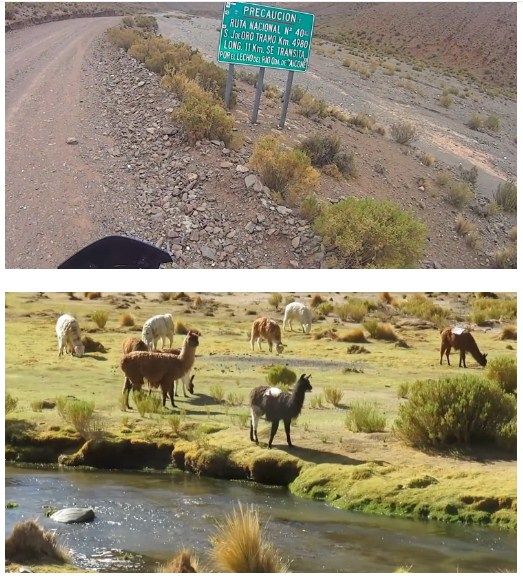
Cruzamos (yo y mi moto) el puente sobre el río seco de La Quiaca que separa o divide ambos países.
La disputa por esta fuente generó en el pasado muchas rivalidades y peleas entre los dos países sudamericanos.
Hasta no hace mucho llegó un tren.
Este tramo de la Ruta 40 que parte desde el norte es uno de los tramos aún no pavimentados. La grava y el suelo no compactado pusieron a prueba mi bicicleta.
y tiene ese color cobrizo que caracteriza a La Puna.
Continuas bajadas y subidas que, aunque parezcan desoladoras, tienen su encanto.
A pesar de que el clima es árido y semidesértico, viajando en verano nos topamos con algunas lagunas y charcos producto de las recientes lluvias.
La época en la que más llueve es de octubre a marzo.
El viento es frío y fuerte. Por este motivo casi todas las puertas y ventanas de las casas están siempre cerradas. No es por miedo sino para evitar la entrada de suciedad y polvo a las casas. Y contrasta con la hospitalidad de la gente.
Son bastante habituales las advertencias destinadas a circular con precaución por los caminos de tierra.
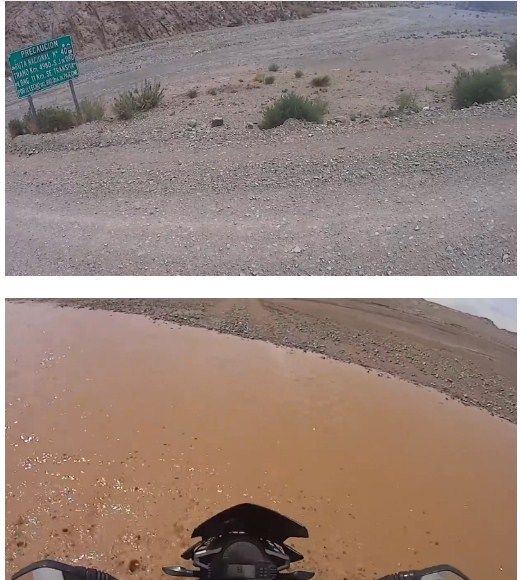
Y finalmente veo los primeros signos de vida animal: las llamas de animales típicas y símbolo de la Puna jujeña.
La gente no te conoce pero te saluda al pasar.
Personas que aprecian el espíritu del viajero y sus ganas de saber.
Aquí estamos a 11 kilómetros sobre el lecho del desfiladero de Paicone.
Estas tierras parecen sacadas de la paleta de un pintor. Y de hecho ese es el nombre de una de estas colinas multicolores. Aquí se cultivan flores de hoja perenne y hay algunas obras de arte rupestre.
A veces los colores de La Puna parecen fundirse con el color mismo del territorio, con sus pueblos embarrados y su gente sin prisas.
La gente también ha aprendido a vivir del turismo. Puedes caminar por caminos empedrados o viajar con una caravana de llamas.
Los desniveles del recorrido, la grava y el terreno no consolidado requieren continuos avisos.
La ruta 40 hacia el norte cruza el lecho de varios ríos y corta durante 11 km el lecho de un arroyo seco. Los cardones están en flor.
No hay ruidos ni preocupaciones. No hay publicidad ni centros comerciales. Ni los políticos ni los bancos.
Aquí el alma se calma y el corazón recupera la razón.
Paso la noche en un colegio a 3.800 metros de altura. Hace frío pero el ánimo está cálido para iniciar la segunda etapa.
Llego a San Antonio de los Cobres.
He recorrido 444 kms en mi primer día, por camino de ripio, atravesando barrancas, lagunas, subidas y bajadas con los cerros testigos, sin servicios para el viajero, estaciones de servicio ni alojamiento.
El gran recorrido de la Ruta 40 en Argentina de norte a sur: la primera etapa, desde La Quiaca hasta San Antonio de los Cobres.
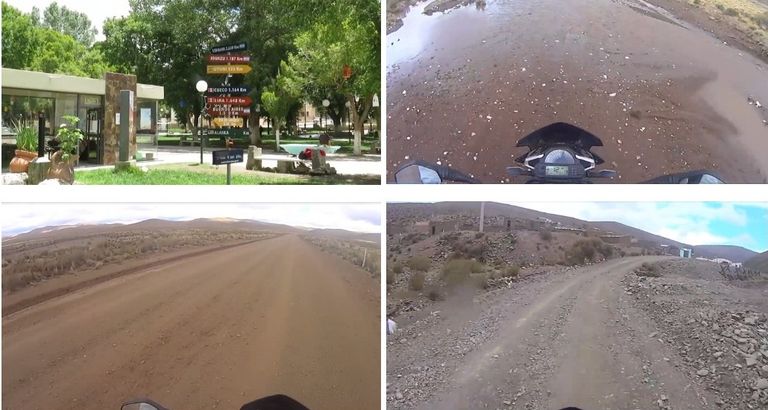
Source initial image / Fuente imagen inicial: Ruta 40.
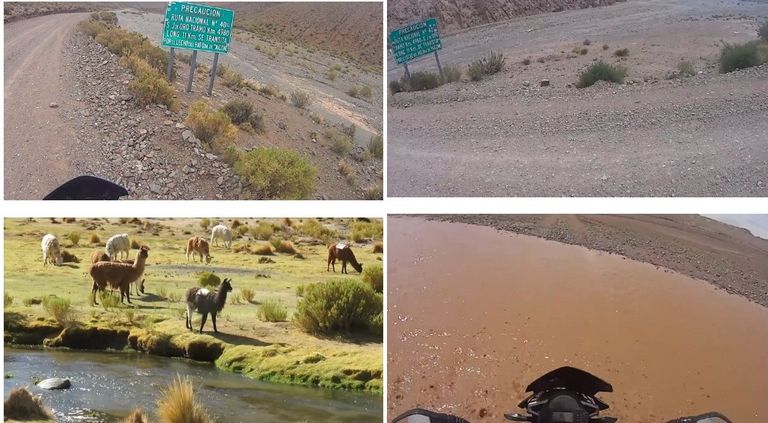


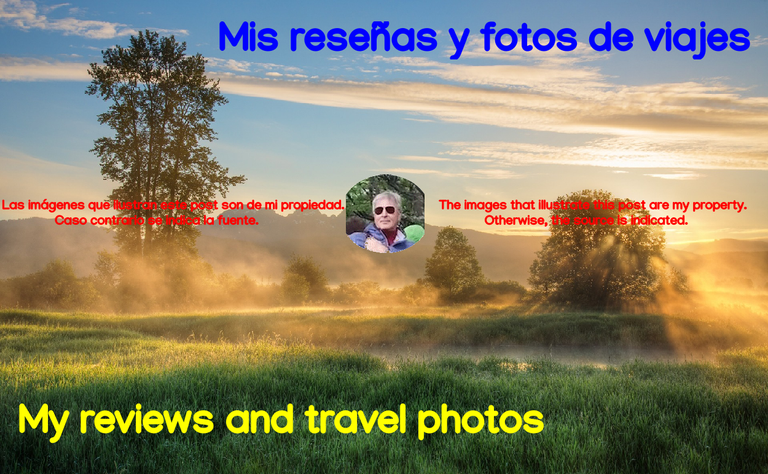
Sources consulted (my property) for the preparation of this article. Some paragraphs may be reproduced textually.
Fuentes consultadas (de mi propiedad) para la elaboración del presente artículo. Algunos párrafos pueden estar reproducidos textualmente.
| Argentina Discovery. |  |
|---|---|
| Galería Fotográfica de Argentina. |  |
| Viaggio in Argentina. |  |

Upvoted. Thank You for sending some of your rewards to @null. Read my last posts to make sure that BLURT burning is profitable for you. Before using this bot please make sure your account has at least 100 BP. Get more BLURT:
@ mariuszkarowski/how-to-get-automatic-upvote-from-my-accounts@ blurtbooster/blurt-booster-introduction-rules-and-guidelines-1699999662965@ nalexadre/blurt-nexus-creating-an-affiliate-account-1700008765859@ kryptodenno - win BLURT POWER delegation@ ctime/burn-bot-liquid-blurtThnks @ctime and team.
Hi @argenvista, great news! Your content was selected by curators @ten-years-before, @nalexadre to receive a special curation from BeBlurt 🎉 Don't hesitate to upvote this comment as the curators will receive 80% of the rewards for their involvement.
You can support us by voting for our witness, our decentralized funding proposal, or through delegation. You're also welcome to join our Discord server 👉 https://discord.beblurt.com
Thank you @beblurt for the continued support. My thanks to @ten-years-before and @nalexadre.